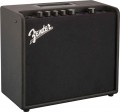Power
Rated power of the device.
Let us recall that in acoustics the rated power is the highest average (root mean square) power of a sound or signal that a device can produce for an indefinitely long time. Individual volume jumps can be several times higher than this indicator, but the key characteristic is the average value. But the specific meaning of this parameter depends on the type of equipment (see above). So, for combo amplifiers, this paragraph usually gives the power of the built-in speakers; The capabilities of your own amplifier, by definition, correspond to this figure, so for such equipment the rated power determines solely the overall sound volume. The power of the acoustics is also indicated for cabinets, but here another point becomes relevant - compatibility with an external amplifier (primarily the “head”). The output power of this amplifier should not be higher than the rated power of the cabinet to avoid overloads; and ideally, these characteristics should match - this will allow you to use the speaker at full power without sound distortion.
For the head, accordingly, this paragraph provides the rated output power, which determines the ability of the amplifier to operate with a specific cabinet or other speakers. However, it is worth noting that the maximum possible power value is indicated as the nominal value for heads, which is not always achieved. Thus, many models provide several sound outputs - for passive acoustics with different...impedances (remember, standard impedance values are 2, 4, 8 and 16 Ohms); and the higher the impedance of the connected speaker, the lower the actual power will be. Other heads have the ability to limit the maximum power - for example, so that at the maximum level the device produces not 100 W, but 50 W or even 25 W. Sometimes these features are combined in one device.
In any case, when choosing according to this indicator, it is worth taking into account the features of the planned use of the equipment. For example, it hardly makes sense to purchase even a 40-watt “combination” for practicing at home - for these purposes 15 watts, or even less, will be quite enough. And if we are talking about a tube device, then in our example the maximum recommended power will be only 5 W - the specificity of tube circuits is such that with the same rated power they are more effective than transistor ones in terms of audibility. For rehearsals in a group without a drum kit (for example, two guitars plus a bass), a higher power is desirable, about 40 “transistor” watts, and if there are drums, at least 60 watts. Transistor devices with a power of up to 150 W and tube devices with a power of up to 40 - 50 W are suitable for specialized rep bases and concerts in relatively small rooms, and higher figures are found mainly in equipment for large-scale events. Detailed recommendations regarding optimal power for certain conditions can be found in special sources.
It is worth mentioning bass amplifiers separately: it is believed that for normal coordination with each other, the power of a bass “combination” should be twice as high as the power of a guitar one.
Impedance
The impedance of the speaker(s) installed in the amplifier.
Impedance is the resistance to alternating current — that is, the current flowing when an audio signal is applied. This impedance affects the compatibility of the speaker with the power amplifier: if the impedance is too low, sound distortion occurs, if the impedance is too high, the volume is reduced. However, in combo amplifiers, this parameter is most often given as a purely reference: such devices have their own power amplifier, which, by definition, is designed for the impedance of the “native” speaker, and separately, with extraneous components, the speaker and amplifier are not used.
Number of speakers
The number of speakers provided in the design of the device.
This parameter is indicated in cases where there is more than one speaker. Its meaning may vary. Thus, in some models several speakers are provided to be divided into frequency bands (see “Number of bands”); in this case, a small high-frequency emitter can be installed directly in front of the low-frequency one (the so-called coaxial circuit). In other devices, several speakers of the same type are used to provide the necessary sound power - for a number of reasons this is preferable to installing a single powerful speaker.
Woofer size (LF/MF)
The diameter of the woofer or woofer installed in the combo amplifier. The specific value of this parameter may be different, depending on the number of lanes (see above). In three-way systems we are talking about bass dynamics, in two-way systems — about the dynamics responsible for low and medium frequencies; and if the amplifier does not have band separation, this paragraph indicates the diameter of the main radiator.
In general, the larger the radiator, the louder it can sound and the richer the bass from such a speaker is. At the same time, we note that the speaker diameter is selected by the manufacturer based on the power of the built-in amplifier and the expected sound volume. So the main indicator when choosing is still the rated power, and the size of the speaker is more of a reference value.
Built-in looper
The presence
of a built-in looper in the amplifier.
Looper is a module that allows you to record and loop a specific piece of music. Using this function, you can, for example, record a rhythm guitar part directly into the “amp”, turn it on for playback and work out the solo part to the accompaniment played through the looper.

